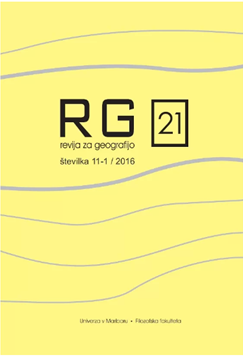The demographic ageing of population in Bosnia and Herzegovina: causes and consequences
DOI:
https://doi.org/10.18690/rg.11.1.3951Keywords:
demographic ageing, age structure, population, demographic changes, Bosnia and HerzegovinaAbstract
In this paper the age structure and the ageing population process in Bosnia and Herzegovina in the second half of the 20th century and the beginning of the 21st century is analyzed. The main reasons that caused changes in the age composition of the population and the population ageing in Bosnia and Herzegovina have been researched. The main causes of the population ageing in Bosnia and Herzegovina in the second half of the 20th century were primarily trends in fertility rates and secondarily trends in mortality rates. The economic growth of Bosnia and Herzegovina after World War II conditioned changes in the economic and educational structure of the population and with that the changes in the natural increase rates and migration balance. The war was the main cause of negative demographic changes in Bosnia and Herzegovina in the period from 1992 to 1995, and the post-war adverse socioeconomic, political and other circumstances have been the cause of negative demographic trends after 1995. The aim of this paper is to determine the level of population ageing in Bosnia and Herzegovina and the consequences this process could have on the demographic future of this country.
Downloads
References
Bošnjović, I. 1990: Demografska crna jama - nova zamka industrijskog društva. Veselin Masleša. Sarajevo.
d`Albis, H, Collard, F. 2013: Age groups and the measure of population aging. Demographic Research, Volume 29, Article 23. 10.4054/DemRes.2013.29.23.
Demographics of Bosnia and Herzegovina 2008, Thematic Newsletter 02. Agency for statistics of Bosnia and Herzegovina, Sarajevo.
Females and males in Bosnia and Herzegovina 2009. Agency for statistics of Bosnia and Herzegovina, Sarajevo.
Frejka, T., Sobotka, T. 2008: Fertility in Europe - Diverse, delayed and below replacement. Demographic Research, Volume 19, Article 3. 10.4054/DemRes (2008.19.3).
Friganović, M. 1990: Demogeografija - stanovništvo svijeta. Školska knjiga. Zagreb.
Hoff, A. 2008: Population aging in Central and Eastern Europe as an outcome of the socio-economic transition to capitalism. Socialinis Darbas, No. 7 (2). Vilnius.
Ibreljić, I., Kulenović, S., Kadušić, A., Smajić, S. 2006: Migration flows in Bosnia and Hercegovina after 1992. 46th Congress of European Regional Science Association (ERSA). Volos, Greece. Internet: http://www-sre.wu-wien.ac.at/ersa/ersaconfs/ersa06/papers/173.pdf (10.10.2015).
Informacija o stanju iseljeništva iz Bosne i Hercegovine 2012. Ministarstvo za ljudska prava i izbjeglice. Sarajevo.
Kerbler, B. 2015: Population Aging in Slovenia - A Spatial Perspective. Acta geographica Slovenica, 55-2. Ljubljana. http://dx.doi.org/10-3986/AGS-1885.
Kinsella, K., Phillips, D. R. 2005: Global Aging - The Challenge of Success. Population Bulletin Vol. 60, No. 1. Population Reference Bureau (PRB). Washington, DC.
Migracioni profil Bosne i Hercegovine za 2011. godinu. Ministarstvo sigurnosti BiH, Sektor za imigraciju. Sarajevo.
Mirkin, B., Weinberger, M. B. 2001: The demography of population ageing. United Nations Population Bulletin, Special Issue No. 42/43. New York.
Natural population change 2013, Report number 1, Year VIII. Agency for statistics of Bosnia and Herzegovina, Sarajevo.
Nejašmić, I. 2005: Demogeografija - stanovništvo u prostornim odnosima i procesima. Školska knjiga. Zagreb.
Nejašmić, I., Toskić., A. 2013: Starenje stanovništva u Hrvatskoj - sadašnje stanje i perspektive. Hrvatski geografski glasnik 75/1. Zagreb.
Sentić, M. 1971: Naši građani na privremenom radu u inostranstvu. Stanovništvo, Broj 1-2. Institut društvenih nauka, Centar za demografska istraživanja. Beograd.
Tasić, J. 1963: Dugoročne promjene starosne strukture stanovništva Jugoslavije. Stanovništvo, Godina I, Broj 1. Institut društvenih nauka, Centar za demografska istraživanja. Beograd.
Wertheimer-Baletić, A. 1999: Stanovništvo i razvoj. Mate-Zagreb. Zagreb.
Internet 1: World Population Aging 1950-2050. Population Division 2015. United Nations. http://www.un.org/esa/population/publications/worldageing19502050/pdf/80chapterii.pdf (29.09.2015).
Internet 2: World Population prospects: The 2015 Revision. United Nations Department of Economic and Social Affairs/Population Division. http://esa.un.org/unpd/wpp/publications /files/key_findings_wpp_2015.pdf (04.01.2015).
Internet 3: World Population Aging 2013. United Nations Department of Economic and Social Affairs/Population Division. New York. http://www.un.org/en/development/desa/ population/publications/pdf/ageing/WorldPopulationAgeing2013.pdf. (08.01.2015).
Downloads
Published
Issue
Section
License
Copyright (c) 2016 Alma Kadušić, Alija Suljić, Nedima Smajić

This work is licensed under a Creative Commons Attribution 4.0 International License.
